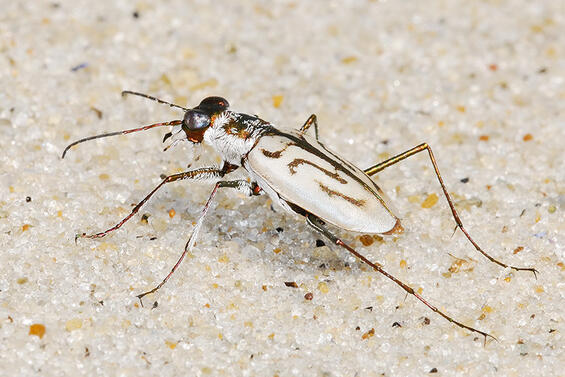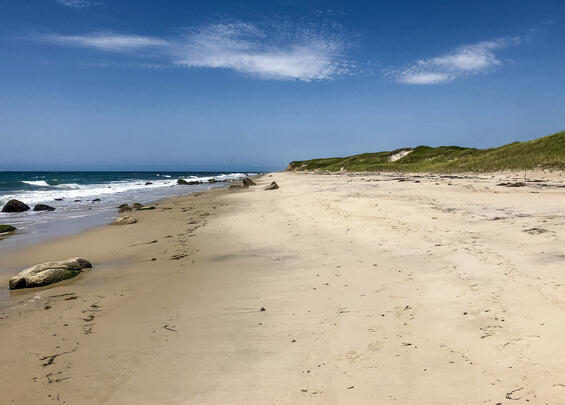- Scientific name: Habroscelimorpha dorsalis
- Species of Greatest Conservation Need (MA State Wildlife Action Plan)
- Endangered (MA Endangered Species Act)
- Threatened (US Endangered Species Act)
Description

Northeastern beach tiger beetle (Habroscelimorpha dorsalis)
Tiger beetles are so named because of their “tiger-like” behavior of chasing down and capturing prey with their long mandibles. The northeastern beach tiger beetle (Cicindela dorsalis) is 13-15 mm (0.5-0.6 in) in length (Pearson et al. 2015). It has a bronze head and thorax, white elytra (wing covers) imprinted with bronze maculations (markings), and long, slender, bronze legs. The grub-like larva of the northeastern beach tiger beetle has an iridescent green and bronze head, an iridescent bronze pronotum (“neck”) covered with setae (hairs), and a long, segmented, white abdomen. The northeastern beach tiger beetle is one of four subspecies of the eastern beach tiger beetle (Habroscelimorpha dorsalis); however, only the nominate subspecies (Habroscelimorpha dorsalis dorsalis) occurs in Massachusetts. The hairy-necked tiger beetle (Cicindela hirticollis) is also found on coastal beaches, including those inhabited by the northeastern beach tiger beetle. However, the elytra of the hairy-necked tiger beetle are dark brown to greenish-brown with white maculations.
Life cycle and behavior

The northeastern beach tiger beetle has a two-year life cycle. Adult northeastern beach tiger beetles are active from mid-June to early September, with activity peaking in July. The adult beetles forage in the intertidal zone, preying on small invertebrates and scavenging dead fish. They are primarily active during the day but are occasionally active at night. Mating occurs in July and early August. Females lay their eggs in the sand in the intertidal zone. By early September most, if not all, of the adult beetles have died. Eggs hatch in August or early September. Larvae inhabit burrows in the beach. The burrows of recently hatched larvae are within a few meters of the high tide line. Burrows of overwintering larvae are located higher on the beach, further from the tide line, near or sometimes beyond the edge of dune vegetation. The following summer, larvae have moved their burrows back down the beach, closer to the tide line. The change in burrow location often parallels the erosion and accretion cycle of the beach, which widens in summer as sand is deposited, and narrows in winter as it is eroded by storm wind and waves. Larvae of the northeastern beach tiger beetle are voracious predators. A larva’s sensory organs detect vibrations made by small invertebrate prey. When prey is close, the larva lunges out of its burrow and captures its victim with strong, serrated jaws. The prey is dragged into the burrow and devoured. In Massachusetts, the most common prey for larvae is the “sand flea” (an amphipod crustacean), which is often abundant in wet sand near the tide line.
Distribution and abundance
Historically the northeastern beach tiger beetle could be found along the Atlantic Coast from Massachusetts to Virginia. It is currently only found at the extremities of its former range: in the Chesapeake Bay of Maryland and Virginia, and two populations in Massachusetts.

Distribution in Massachusetts. 2000-2025. Based on records in the Natural Heritage Database.
Habitat
The northeastern beach tiger beetle is a coastal species that inhabits large, exposed ocean beaches with fine sand particles and a low density of human disturbance. In Massachusetts, high-quality habitat consists of wide beaches with a well-developed and dynamic dune system. Typically, the dominant vegetation of the upper beach and dunes is dune grass (Ammophila breviligulata). Adult beetles occur in greater numbers, and reproduction (larval growth to maturity) is most successful on beaches largely undisturbed by human activity, in particular with little or no off-road vehicle traffic. Adult beetles may occur, and presumably reproduction is successful to some degree, on beaches with less intense use (walking, sunbathing, swimming) by a relatively small number of people. In contrast, beaches crowded with a density of such human activity are largely uninhabited, though an occasional “stray” beetle may be observed.
Healthy habitats are vital for supporting native wildlife and plants. Explore habitats and learn about conservation and restoration in Massachusetts.

Ocean shoreline sand beach with dunes, habitat for the northeastern beach tiger beetle.
Threats
Historically, the northeastern beach tiger beetle was more widespread on Cape Cod and the offshore islands but has not inhabited most Massachusetts beaches for decades. Increased intensity of recreation, in particular off-road vehicle traffic, is responsible for the disappearance of all but two Massachusetts populations (as well as many others along the Atlantic Coast). Off-road vehicles kill both adult beetles and larvae by crushing them and damaging larval burrows. As a result, larvae must reduce feeding time and expend considerable energy repairing their burrows. Another threat to this species is beach and dune nourishment (addition of sand), which interferes with the natural cycle of beach erosion and accretion, to which the life cycle of the northeastern beach tiger beetle is adapted. Insecticide spraying is a potential threat. This species is vulnerable to climate change, as its habitat is threatened by sea level rise.
Conservation
Land protection and habitat management are the primary conservation needs of the northeastern beach tiger beetle in Massachusetts. Coastal beach and dune systems should be conserved, restored, and managed for this species and other species dependent on such habitat.
Survey and monitoring
The distribution of the northeastern beach tiger beetle in Massachusetts is well documented. The two remaining populations in the state should be monitored annually to document changes in population size and habitat condition.
Management
Management of coastal beach and dune systems benefits a variety of species, including the northeastern beach tiger beetle. At beaches where this species still occurs and successfully reproduces, off-road vehicles should be excluded. Beach nourishment (addition of sand) should be avoided, but if necessary, sand from on-site (immediately offshore) should be used. In addition, large-scale nourishment projects should be staged to avoid impacting a significant number of beetles or larvae. Habitat condition should be monitored and management adapted as needed.
Research needs
The natural history and conservation needs of the northeastern beach tiger beetle are well understood. The future effects of climate change on this species, in particular sea level rise, will likely be detrimental and should be documented.
References
Pearson, D.L., C.B. Knisley, D.P. Duran, and C.J. Kazilek. 2015. A Field Guide to the Tiger Beetles of the United States and Canada. Oxford University Press, New York, New York. 251 pp.
Contact
| Date published: | April 16, 2025 |
|---|